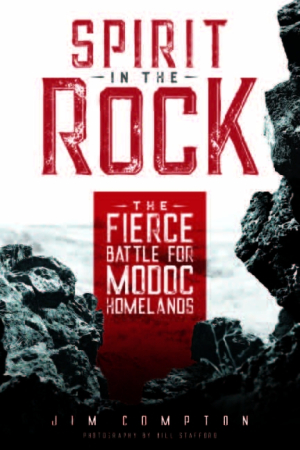Spirit in the Rock
The Fierce Battle for Modoc Homelands
- 2017 INDIES Winner
- Honorable Mention, History (Adult Nonfiction)
Compton skillfully brings to life a fierce fight on the frontier.
Jim Compton’s Spirit in the Rock tells the captivating story of the Modoc War, the most expensive Indian conflict in American history. This well-researched book by a veteran broadcast journalist cites many firsthand accounts from the front line of a war along the California-Oregon border.
Spirit gives a definitive account of how Oregon Trail homesteaders started to displace the native Modoc tribe from its homeland around Tule Lake, leading to a war in 1872-1873. The book recounts how the young and charismatic chief Captain Jack refused to leave the ancestral home at Lost River, prompting a surprise attack during peace negotiations that led to many battles and a shocking end.
Compton’s writing shines in passages like “The river swarmed with suckerfish and trout, so abundant it was said you could walk across the river on their backs.” He deftly portrays Indian life on the West Coast before it was violently disrupted by settlers.
He paints a detailed portrait of how fifty-two Modoc warriors held off a force of a thousand government soldiers in a deadly conflict that has also been called the Lava Beds War. He brings to life historical figures like Captain Jack, Shacknasty Jim, Boston Charley, General Edward Canby, and Alfred Meacham. The research is so thorough that even gunfights are recounted shot by shot. This factually buttressed narrative is supplemented by photos and maps.
The book brims with passion, shining a much-needed light on a generally overlooked chapter in United States history. Compton explains what happened during the Indian war, gives the requisite context, and outlines the aftermath with the thoroughness of a good reporter.
Compton died shortly after finishing the manuscript, and his wife, Carol Arnold, extensively edited the book and submitted it to publishers. Spirit in the Rock is an impressive achievement of historical scholarship that chronicles the the life of the Modoc tribe and the violence the United States deployed to uproot it.
Reviewed by
Joseph S. Pete
Disclosure: This article is not an endorsement, but a review. The publisher of this book provided free copies of the book to have their book reviewed by a professional reviewer. No fee was paid by the publisher for this review. Foreword Reviews only recommends books that we love. Foreword Magazine, Inc. is disclosing this in accordance with the Federal Trade Commission’s 16 CFR, Part 255.

